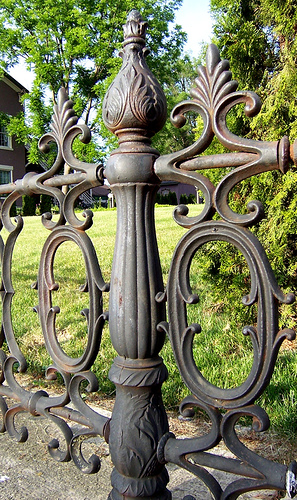You know the saying about fences and neighbours? Well, good fences also make for good property prices. At least, poorly maintained fences and fencing that doesn’t match the look and feel of the property will have an adverse effect on your property’s value. Think about it, if you drove up to a house for sale and saw the paint peeling off the wooden fence, or noticed holes in the hedge, or were faced with a monstrous brick wall with curlicues and niches with statues while the house behind it was a miner’s cottage, would you be tempted to buy?
Appearances count for everything in the property market and in many cases, the first thing that house hunters see is the fence or wall. So, what factors should you consider when it comes to choosing a fence?
Aesthetics
You want something pretty. Walls are designed to keep people out (and sometimes to keep people in) but they should at least not be an eyesore. Chain link fences maybe practical but they get 0/10 when it comes to appeal. You can pretty up and even hide chain link behind a hedge, though. Picket fences are pretty, if somewhat twee. Palisade fences aren’t too bad in the attractiveness stakes, although they offer no privacy.

Bricks come in a variety of colours to suit different house styles, which make them a good option.
Even concrete can be spruced up with precon panels and paint.
Security
Flimsy fences can make people feel vulnerable, which is not what they want. Picket fences aren’t known for their ability to keep baddies out of the yard. Palisade fences, on the other hand, have a reputation for security. Six-foot brick walls can look formidable but they can be scaled.
In the interests of security, people have come up with wall accessories (if you will). Barbed wire is not terribly attractive but it serves a purpose on top of brick walls. You can also get ‘ivy’- spiky metal leaves that look like plants but can be rather painful when grabbed. Some people resort to crushed glass on top of their fences. It’s not necessarily effective and can look like you live in a gangland.
An alternative to barbed wire is electric fencing – a few rows of high voltage wire on top of you wall or fence can be most effective and doesn’t detract from the overall aesthetic.
Maintenance
How much work are you willing to put into maintaining your fence? How much work do you think potential buyers will want to put in?
Brick walls require the least maintenance. You might have to hose them down occasionally but they mostly just stand there and take care of themselves.
Anything wood will require upkeep. Wooden fences are prone to weathering and suffer a great deal or wear and tear. They will need to be sanded and repainted frequently. You’ll need to check for woodworm, termites and rot and will have to replace broken slats, poles and panels immediately.
Concrete requires about as much maintenance as brick; unless you’re going to paint it, in which case you will need to repaint it fairly often as it is faded by the sun and starts to peel.
Metal fences, like palisades, also need painting and, depending on where you live, treatment for rust.
Vinyl is increasingly used as a wood replacement. It doesn’t require as much maintenance and is somewhat more durable.
Hedges also need maintenance and aren’t for people who don’t have a tinge of green in their thumbs. You need to keep the plant healthy and in good condition. It will also need to be trimmed and kept neat.
Cost
This is a major factor. Bricks and precon can be quite expensive on the outset but you need to weigh it up against the savings in maintenance and their durability. Vinyl is more affordable but not everyone likes the look.
Ultimately, the type of fence you choose depends on your taste, but it’s always a good idea to keep the prospect of potential buyers in mind.
This guest post was written by Sandy Cosser on behalf of Ooba, a financial services provider that specialises in helping clients secure first and seconds bonds at competitive interest rates.

